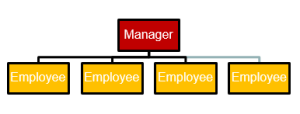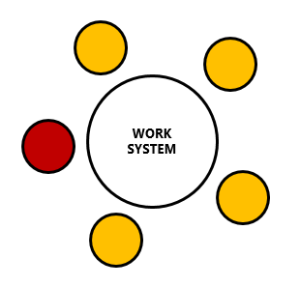Circle Work: achieving cross-functional customer focus
A TEAM OF OWNERS
Ask any group of people to draw their ‘org chart’, and they’re going to draw something like this:
There is nothing wrong with this – it’s a useful diagram that shows managerial relationships – who is accountable for which teams. This has value simply because if a given team is doing great, or not so great, it’s convenient to know who to talk to. And we can have meetings of five teams by coordinating five calendars instead of forty.
Here’s the thing though – this visual representation becomes the dominant mental model for how we think about work. Notice how it implies four separate people, only connected through one other who sits ‘over’ them. It’s not a big leap from here to see how relationships of dominance and dependence can emerge, with the friendly version being the ‘caretaking’ manager, the not-so-nice version being the autocratic manager. Either way felt ownership of the work is gathered in just the one person. Not nice if you’re that person.
(Click here for a pdf version of this post)
So here’s a change. Draw your team like this….
…as a Circle, that gathers around the work of the team – it’s mission. But notice a key feature – we still have a managerial leadership role. And we define that role very deliberately – as the role that takes accountability for the team delivering it’s mission. So it has the authority to convene meetings, to name the conversation that needs to be had, and, when required, to make decisions if the team can’t naturally find a consensus that makes sense. Read more…






